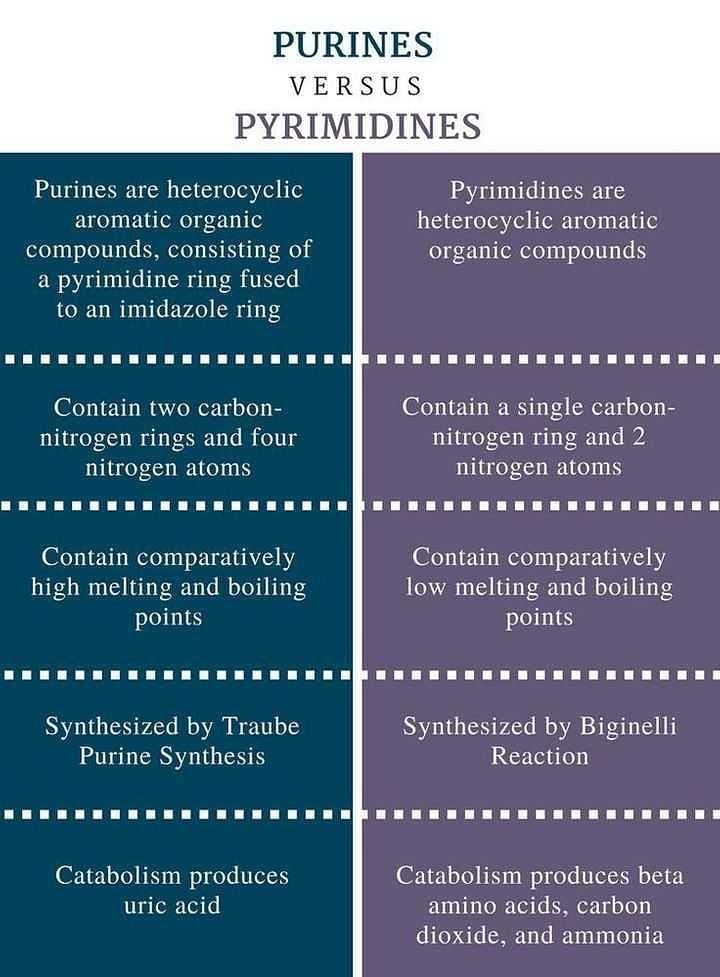NEET Exam > NEET Questions > Difference between purines and pyrimidines ?
Start Learning for Free
Difference between purines and pyrimidines ?
Most Upvoted Answer
Difference between purines and pyrimidines ?

Community Answer
Difference between purines and pyrimidines ?
Purines vs Pyrimidines
Structures:
- Purines have a double-ring structure made up of a six-membered ring fused to a five-membered ring (adenine and guanine).
- Pyrimidines have a single-ring structure with only a six-membered ring (cytosine, thymine, and uracil).
Composition:
- Purines consist of adenine and guanine, while pyrimidines consist of cytosine, thymine, and uracil.
Base Pairing:
- In DNA, adenine pairs with thymine (A-T) through two hydrogen bonds, and guanine pairs with cytosine (G-C) through three hydrogen bonds.
- In RNA, adenine pairs with uracil (A-U) instead of thymine.
Function:
- Purines and pyrimidines are essential components of nucleic acids like DNA and RNA, playing a crucial role in genetic information storage and transfer.
- Purines also serve as components of energy carriers like ATP and GTP, while pyrimidines are involved in various metabolic processes.
Occurrence:
- Purines are found in high amounts in meat, poultry, fish, and legumes.
- Pyrimidines are present in foods like dairy products, eggs, and grains.
Conclusion:
In summary, purines and pyrimidines are fundamental building blocks of nucleic acids, with distinct structural differences and base pairing arrangements. Understanding their roles and differences is essential for comprehending processes like DNA replication, transcription, and translation.
Structures:
- Purines have a double-ring structure made up of a six-membered ring fused to a five-membered ring (adenine and guanine).
- Pyrimidines have a single-ring structure with only a six-membered ring (cytosine, thymine, and uracil).
Composition:
- Purines consist of adenine and guanine, while pyrimidines consist of cytosine, thymine, and uracil.
Base Pairing:
- In DNA, adenine pairs with thymine (A-T) through two hydrogen bonds, and guanine pairs with cytosine (G-C) through three hydrogen bonds.
- In RNA, adenine pairs with uracil (A-U) instead of thymine.
Function:
- Purines and pyrimidines are essential components of nucleic acids like DNA and RNA, playing a crucial role in genetic information storage and transfer.
- Purines also serve as components of energy carriers like ATP and GTP, while pyrimidines are involved in various metabolic processes.
Occurrence:
- Purines are found in high amounts in meat, poultry, fish, and legumes.
- Pyrimidines are present in foods like dairy products, eggs, and grains.
Conclusion:
In summary, purines and pyrimidines are fundamental building blocks of nucleic acids, with distinct structural differences and base pairing arrangements. Understanding their roles and differences is essential for comprehending processes like DNA replication, transcription, and translation.
Attention NEET Students!
To make sure you are not studying endlessly, EduRev has designed NEET study material, with Structured Courses, Videos, & Test Series. Plus get personalized analysis, doubt solving and improvement plans to achieve a great score in NEET.

|
Explore Courses for NEET exam
|

|
Similar NEET Doubts
Difference between purines and pyrimidines ?
Question Description
Difference between purines and pyrimidines ? for NEET 2024 is part of NEET preparation. The Question and answers have been prepared according to the NEET exam syllabus. Information about Difference between purines and pyrimidines ? covers all topics & solutions for NEET 2024 Exam. Find important definitions, questions, meanings, examples, exercises and tests below for Difference between purines and pyrimidines ?.
Difference between purines and pyrimidines ? for NEET 2024 is part of NEET preparation. The Question and answers have been prepared according to the NEET exam syllabus. Information about Difference between purines and pyrimidines ? covers all topics & solutions for NEET 2024 Exam. Find important definitions, questions, meanings, examples, exercises and tests below for Difference between purines and pyrimidines ?.
Solutions for Difference between purines and pyrimidines ? in English & in Hindi are available as part of our courses for NEET.
Download more important topics, notes, lectures and mock test series for NEET Exam by signing up for free.
Here you can find the meaning of Difference between purines and pyrimidines ? defined & explained in the simplest way possible. Besides giving the explanation of
Difference between purines and pyrimidines ?, a detailed solution for Difference between purines and pyrimidines ? has been provided alongside types of Difference between purines and pyrimidines ? theory, EduRev gives you an
ample number of questions to practice Difference between purines and pyrimidines ? tests, examples and also practice NEET tests.

|
Explore Courses for NEET exam
|

|
Suggested Free Tests
Signup for Free!
Signup to see your scores go up within 7 days! Learn & Practice with 1000+ FREE Notes, Videos & Tests.

























